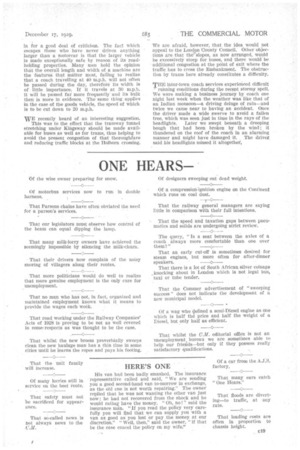LOOSE LEAVES
Page 40

Page 41

If you've noticed an error in this article please click here to report it so we can fix it.
IT is rather interesting to note the extraordinary longevity of some commercial vehicles. For instance, that of which we reproduce a photo
graph is an old LC-type Commer, which was purchased in June, 1908, by E. Chesworth, of Bronington, and shows a party leaving Hanmer, in Flintshire, for Llangollen, in August of that year. The remarkable point, however, is that the owner states the chassis is still in service in the Liverpool district.
RECENTLY, in a wait ing-room at a commercial-vehicle factory we noticed several old copies of The Commercial Motor lying, on the table, together with the then current issue. The copies in qution contained marked articles in which were stressed the import ciS amee of shed days and the need for adequate capital when starting business. This company does a large proportion of its business with operators of single veh cles and mall fleets. The sales manager said that half his troubles were due to improper use of vehicles and the more the user is educated the better for the maker—as well as for the operator himself. He keeps the copies in the waiting-room in the hope that the seeds a sense may fall upon fruitful ground AS might be expected, there are many heated discussions over lunch in every business-mates restaurant throughout the land on the topic of the -Road Traffic Bill. Naturally the suggested speed limit of 30 m.p.h. -for coaches and buses comes . in for a good deal of criticism. The fact which escapes those who have never driven anything larger than a motorcar is that the larger vehicle is made exceptionally safe by reason of its roadholding properties. Many men hold the opinion that the overall length and width of a machine are the features that matter must, failing to realize that a coach travelling at 40 m.p.h. will not often be passed during_ the day, therefore' its width is of little importance. If it travels at 30 m.p.h. it will be passed far more frequently' and its bulk then is more in evidence. The same thing applies in the case of the goods vehicle, the speed of which is to be cut down to 20 m.p.h.
WE recently heard of an interesting suggestion. This was to the effect that the tramway tunnel stretching under Kingsway should be made available for buses as well as for trams, thus helping to avoid the present congestion of that thoroughfare and reducing traffic blocks at the Holborn crossing. We are afraid, however, that the idea would pot appeal to the London1County Council. Other objectiOns are that theslopes, as now arranged, would be excessively steep for buses, and there would be additional congestion at the paint of exit where the traffic has to cross the Embankment. The obstruction by trams here already constitutes a difficulty.
THE inter-town coach services experienced difficult running conditions during the recent stormy spell. We were making a business journey by coach one night last week when the weather was like that of an Indian monsoon—a driving deluge of rain—and twice we came near to having an accident. Once the driver made a wide swerve to avoid a fallen tree, which was seen just in time in the rays of the headlights. Later we swept beneath a drooping bough that had been broken by the wind; it thundered on the roof of the coach in an alarming manner and might have damaged it. The drivet said his headlights missed it altogether.












































































































